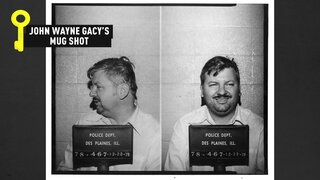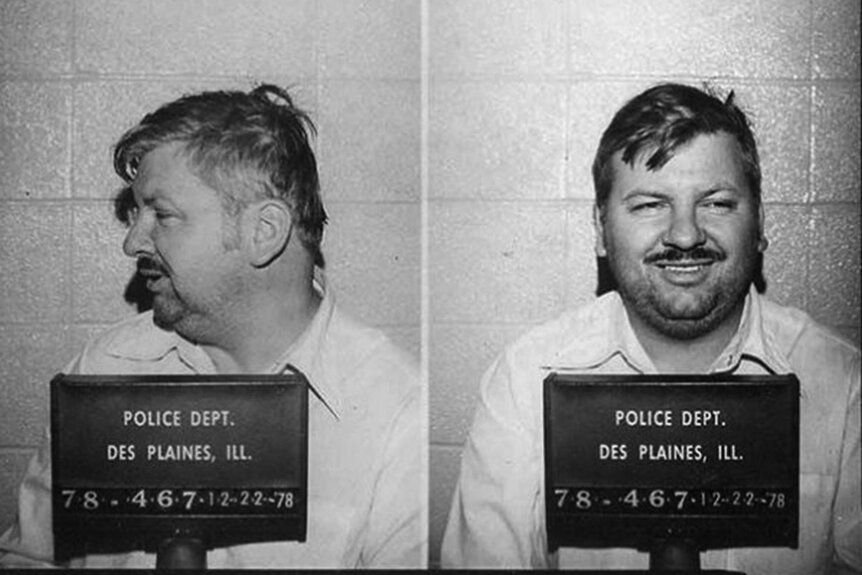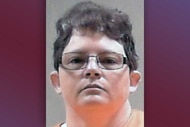Create a free profile to get unlimited access to exclusive videos, breaking news, sweepstakes, and more!
New Series On Serial Killer John Wayne Gacy Raises Serious Questions About The Case’s Narrative And Investigation
"John Wayne Gacy: Devil in Disguise" premieres on Peacock Thursday, March 25.

The narrative surrounding serial killer John Wayne Gacy’s crimes is well cemented in our collective psyche: the so-called "killer clown" murdered 33 young men and boys in the 1970s and buried most of them in a crawl space under his Chicago-area home.
You'd think that for so highly publicized a case, there'd be no avenues left to explore, but a new docuseries raises questions about the case, not only regarding the investigation, but about the the very environment in which Gacy operated, one that allowed him for years to prey upon his victims with little, if any, scrutiny. Did Gacy truly act on his own? Was he actually the isolated loner he was often portrayed to be? And why did the disappearances of dozens of young men go unsolved for years before the grim discovery under Gacy's home?
“John Wayne Gacy: Devil in Disguise,” a new six-part docuseries premiering on Peacock March 25, tackles those questions, bringing fresh insight into Gacy's horrific murder spree.
(Warning: Some show spoilers ahead.)
The series offers an intimate glimpse into the case — Gacy is believed to have killed his victims from 1972 to 1978 — featuring interviews with investigators, prosecutors, family members, as well as rare footage from a 1992 prison interview with Gacy, conducted two years before his execution. The archival video shows the killer as elusive, often feigning innocence and deflecting blame for the full scope of his crimes. He claims to have never even met some of the slain boys found buried in a mass grave under his home and said he was out of town when others of them vanished.
At first glance, his denials appear to be solely the lies of a man who refuses to take responsibility for his actions. However, the docuseries does explore whether Gacy might have had help in carrying out, or at least covering up, the dozens of murders he committed.
Former Chicago Reader editor Alison True was still working at the weekly paper in the early 2000s when Roosevelt University graduate student Chris Maloney pitched her a Gacy-related story, the Chicago Reader reports. He said a retired Chicago police detective believed there could still be undiscovered Gacy victims in the yard of an apartment building in northwest Chicago, a few miles from the site of Gacy's Des Plaines home. The Reader didn't have the budget to fund the type of investigation a story like that would require, but True offered to help Maloney find another publisher. A year, later, after being fired from the Reader, True again offered to help find a home for the story and ultimately picked up the baton, with Maloney's blessing, of reporting it out further, with the assistance of freelance television producer Tracy Ullman. Together, the pair began investigating numerous Gacy theories, including ideas that there were additional victims, theories that he had accomplices and possible links to sex trafficking and snuff porn rings.
Their research has culminated in the docuseries; Ullman is one of the executive producers and True serves as an investigative consultant on the project.
"There are just a number of lingering questions about the Gacy case," executive producer Alexa Danner told Oxygen.com. "They pertain to whether Gacy may or may not have had more victims. Whether he may or may not have had help with his crimes or other people may have known more about them and not shared it at the time. There's a question of whether he could have been stopped sooner if police had pushed harder when he came into contact with them in earlier occasions before his 1978 arrest."
The docuseries also examines the tragic way that many of the missing persons cases, and even some of Gacy's known survivors, were treated by some investigators. Many of the missing young men were dismissed as runaways, even though their families were adamant something more nefarious was at play. Several were seemingly overlooked because they were believed to be members of the LGBTQ community and other marginalized groups. For example, Jeffrey Rignall, who survived his brush with Gacy after being lured into his car, knocked out with chloroform and then brutally assaulted, had to take it upon himself to investigate his own case, returning to the scene of his abduction time and again until he sighted Gacy's car and was able to trail him, because police initially dismissed his story as part and parcel of the gay sex scene. Through his interviews, Gacy as well routinely blames many of victims found in his home, questioning their innocence and insinuating they were asking for trouble.
The docuseries also features previously unseen crime scene photos and pictures of Gacy in various settings that prove he was a man of many disguises indeed. While his time moonlighting as a party clown is well known, he also rubbed elbows with prominent politicians (and was once photographed with Rosalynn Carter, the first lady at the time, during a political event), in addition to being a brother, husband, father, porn pusher, predator, sadist, manipulator, painter, and of course, liar. The complex portrait of Gacy calls into question the popular narrative surrounding the case.
"We've come to believe that it was a deliberate effort to distort the truth,” True told the Chicago Reader. “Why? Maybe, initially, because Gacy was a precinct captain with political ties; maybe, later, because numerous careers had been built on the resolution of his case; or, maybe because of a connection to a notorious sex trafficking ring operating in Chicago at the time of the Gacy killings.”
Questions persist, but this series chips away at the common story, one that in reality is likely much more complex and nuanced.
"I think for anyone who thinks that they know the Gacy story at all, there is so much more it is an iceberg," Danner told Oxygen.com. "There is so much more to the story."
“John Wayne Gacy: Devil in Disguise,” premieres on Peacock Thursday, March 25.
Oxygen correspondent Stephanie Gomulka contributed to this story.


























